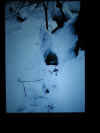| 12-12-05
The first big snow of the year has been an exciting miracle for as long
as I can remember, if for no other reason than the fact that it gives the
land an entirely new look. In the eyes of outdoors folks, there is much
more than beauty to the first big snow, especially if it stays for a spell.
Arrival of the first big snow always tilts my thinking toward tracking
a host of animals (even birds at times), but a snow that remains can even
change ice-fishing patterns and techniques because it creates a permanent
darkness situation under the ice.
Many species of fish--notably those of the sunfish family--are photosensitive
(they become more active as the light of day dims). Members of the sunfish
family that ordinarily feed most heavily before the sun rises, just before
it sets, and at night, tend to go on feeding binges during the bright part
of the day because a blanket of snow has turned the dimmer switch to low.
Thus, I never feel that I am spinning my wheels when I take to snow-covered
ice at the brightest, warmest part of the day.
A blanket of snow does have its “weak” effects on ice, especially if
it comes on thin ice. Snow is a great insulation. As such, it can keep
thin ice thin, or cause thick ice to become rotten and weak, especially
if ground water (or the water of inundated springs) is coming into a small
pond or lake. For this reason, ice anglers--and others using ice-covered
waters for other forms of recreation--should view snow-covered ice with
jaundiced eyes.
In my book, one of the greatest features of the first big snow lies
in the fact that it turns subsequent lighter snows into beautiful tracking
snows. Those who enjoy tracking animals in hunting--or non-hunting situations--think
of a four to six-inch dry (fluffy) snow as best for tracking. But after
such a snow is heated by sunlight and refrozen, it is not ideal for tracking
because small animals leave few (or no) no tracks on crusted snow.
However, a one-inch snow (even less) on crusted snow creates ideal tracking
conditions.
Such conditions played an important role in a successful tracking adventure
for me many years ago when I was in the hardwood hills country of northwestern
Jackson County. I was there to track--and perhaps bag--rabbits, or to just
track animals for the love of the activity.
As I slipped through dense underbrush, I kept hearing strange, low whirring
sounds and seeing strange little imprints in the thin, fluffy snow that
had fallen the previous night on a bed of older snow.
I was baffled by the prints in the snow. They did not resemble animal
tracks in any way, but as I studied them more carefully, and connected
them to the whirring sounds, I realized I was trailing grouse that were
taking to a fluttery flight just above the snow as they moved well ahead
of me from one area of heavy cover (downed tree tops) to another. It didn’t
hurt my head too much to think the tips of their wings were hit skipping
on the snow to leave the strange prints, often ten feet or more apart.
Still, I could follow them.
Once I realized what was happening, collecting the prime ingredients
for a ruffed grouse dinner came easy. I had been moving briskly, and my
movement had spooked the birds well before I was in shotgun range. They
were not spooking badly, just enough to stay well ahead of my position.
I slowed my pace and the next treetop gave me a double on grouse, the first
and only time I have been so lucky.
Click
on thumbnail image for enlarged view.
| The snow trail
told me some animal had taken refuge in this small brush heap and the droppings
confirmed it was a rabbit. (Bayou Bill Photo) |

|
|

